Test Procedure, Merits and Demerits, Example Solved Problems | Analysis of Variance | Statistics - Two Way ANOVA | 12th Statistics : Chapter 3 : Tests Based on Sampling Distributions II
Chapter: 12th Statistics : Chapter 3 : Tests Based on Sampling Distributions II
Two Way ANOVA
TWO-WAY ANOVA
In two-way ANOVA a study variable is compared over three or more
groups, controlling for another variable. The grouping is taken as one factor
and the control is taken as another factor. The grouping factor is usually
known as Treatment. The control factor is usually called Block. The accuracy of
the test in two -way ANOVA is considerably higher than that of the one-way
ANOVA, as the additional factor, block is used to reduce the error variance.
In two-way ANOVA, the data can be represented in the following
tabular form.
Blocks
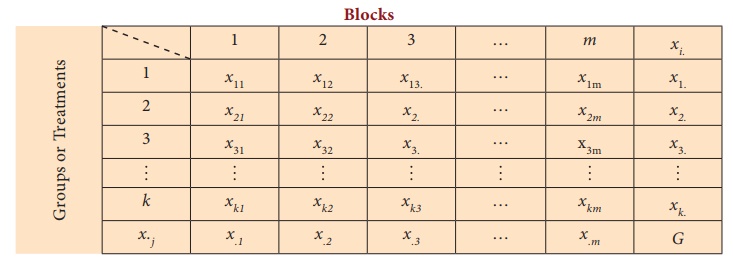
We use the following notations.
xij - ith treatment value
from the jth block, i = 1,2, ..., k;
j = 1,2, ..., m.
The ith treatment total - xi
= ![]() , i 1, 2, ..., k
, i 1, 2, ..., k
The jth block total - x . j
xij , j 1, 2, ..., m
Note that, k ×
m = n, where m = number of blocks, and k = number
of treatments (groups)
and n is the total number of observations in
the study.
The total variation present in the observations xij
can be split into the following three components:
(i) The variation between treatments (groups)
(ii) The variation between blocks.
(ii) The variation inherent within a particular setting or
combination of treatment and block.
1. Test Procedure
Steps involved in two-way ANOVA are:
Step 1 : In two-way ANOVA we have two pairs of hypotheses, one for
treatments and one for the blocks.
Framing Hypotheses
Null Hypotheses
H01: There is no significant difference among the population means of
different groups (Treatments)
H02: There is no significant difference among the population means of
different Blocks
Alternative Hypotheses
H11: Atleast one pair of treatment means differs significantly
H12: Atleast one pair of block means differs significantly
Step 2 : Data is presented in a rectangular table form as described in the previous
section.
Step 3 : Level of significance α.
Step 4 : Test Statistic
F0t (treatments) = MST / MSE
F0b (block) = MSB / MSE
To find the test statistic we have to find the following
intermediate values.
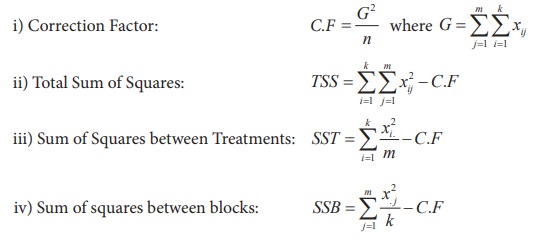
v) Sum of Squares due to Error: SSE = TSS-SST-SSB
vi) Degrees of freedom
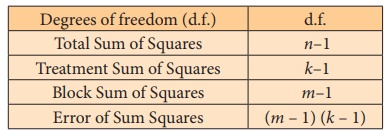
vii) Mean Sum of Squares
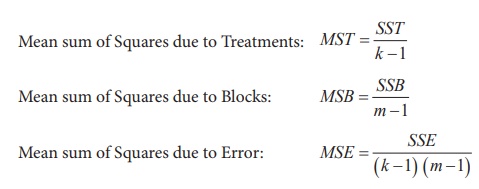
Step 5 : Calculation of the Test Statistic
ANOVA Table (two-way)
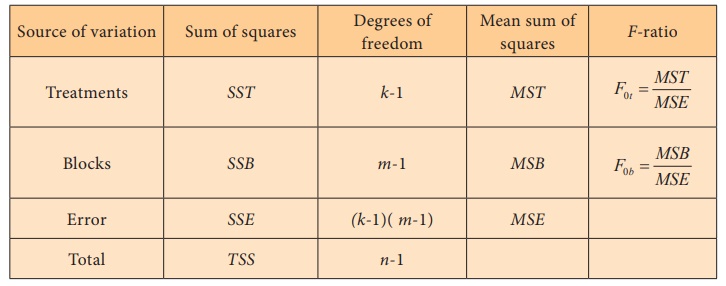
Step 6 : Critical values
Critical value for treatments = f(k-1,(m-1)(k-1)),α
Critical value for blocks = f(m-1, (m-1)(k-1)),α
Step 7 : Decision
For Treatments: If the calculated F0t value is
greater than the corresponding critical value, then we reject the null
hypothesis and conclude that there is significant difference among the
treatment means, in atleast one pair.
For Blocks: If the calculated F0b value
is greater than the corresponding critical value, then we reject the null
hypothesis and conclude that there is significant difference among the block
means, in at least one pair.
2. Merits and Demerits of two-way ANOVA
Merits
·
Any number of blocks and treatments can be used.
·
Number of units in each block should be equal.
·
It is the most used design in view of the smaller total sample
size since we are studying two variable at a time.
Demerits
·
If the number of treatments is large enough, then it becomes
difficult to maintain the homogeneity of the blocks.
·
If there is a missing value, it cannot be ignored. It has to be
replaced with some function of the existing values and certain adjustments have
to be made in the analysis. This makes the analysis slightly complex.
Comparison between one-way ANOVA and two-way ANOVA

Example 3.6
A reputed marketing agency in India has three different training
programs for its salesmen. The three programs are Method – A, B, C. To assess
the success of the programs, 4 salesmen from each of the programs were sent to
the field. Their performances in terms of sales are given in the following
table.

Test whether there is significant difference among methods and
among salesmen.
Solution:
Step 1 : Hypotheses
Null Hypotheses: H01 : μM1= μM2 = μM3 (for
treatments)
That is, there is no significant difference among the three
programs in their mean sales.
H02 : μS1 = μS2 = μS3 = μS4
(for blocks)
Alternative Hypotheses:
H11 : At least one average is different from the other, among the three
programs.
H12 : At least one average is different from the other, among the four
salesmen.
Step 2 : Data

Step 3 : Level of significance α = 5%
Step 4 : Test Statistic
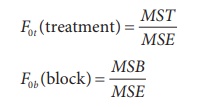
Step-5 : Calculation of the Test Statistic
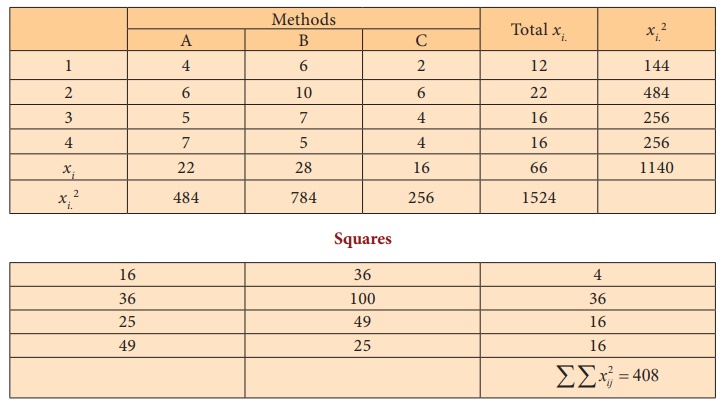
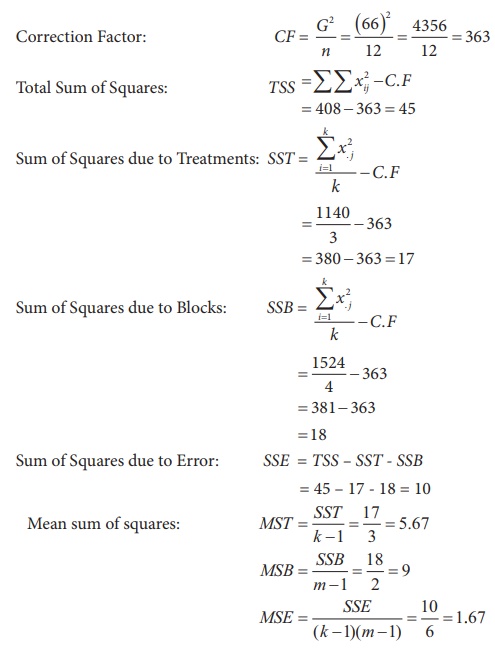
ANOVA Table (two-way)
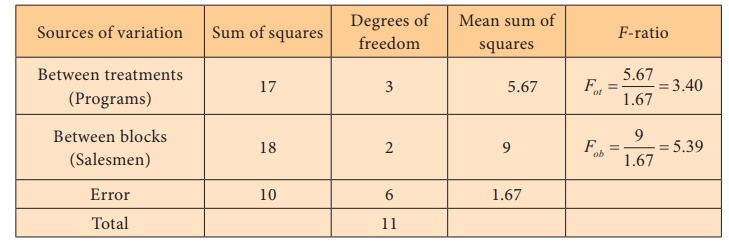
Step 6 : Critical values
f(3, 6),0.05 = 4.7571 (for treatments)
f(2, 6),0.05 = 5.1456 (for blocks)
Step 7 : Decision
(i) Calculated F0t = 3.40 <
f(3, 6),0.05 = 4.7571, the null hypothesis is not rejected
and we conclude that there is significant difference in the mean sales among
the three programs.
(ii) Calculate F0b = 5.39 > f(2,
6),0.05 = 5.1456, the null hypothesis is rejected and conclude that there
does not exist significant difference in the mean sales among the four
salesmen.
Example 3.7
The illness caused by a virus in a city concerning some restaurant
inspectors is not consistent with their evaluations of cleanliness of
restaurants. In order to investigate this possibility, the director has five
restaurant inspectors to grade the cleanliness of three restaurants. The
results are shown below.

Carry out two-way ANOVA at 5% level of significance.
Solution:
Step 1 :
Null hypotheses
H0I : µ1 = µ 2 =
µ 3 = µ 4 = µ5
(For inspectors - Treatments)
That is, there is no significant difference among the five
inspectors over their mean cleanliness scores
H0R : μI = μII = μIII
(For restaurants - Blocks)
That is, there is no significant difference among the three
restaurants over their mean cleanliness scores
Alternative Hypotheses
H1I: At least one mean is different from the other among the
Inspectors
H1R: At least one mean is different from the other among the
Restaurants.
Step 2 : Data

Step 3 : Level of significance α = 5%
Step 4 : Test Statistic
For inspectors: F0a (treatments) = = MST / MSE
For restaurants: F0b (blocks) = MSE / MSB
Step-5 : Calculation of the Test Statistic
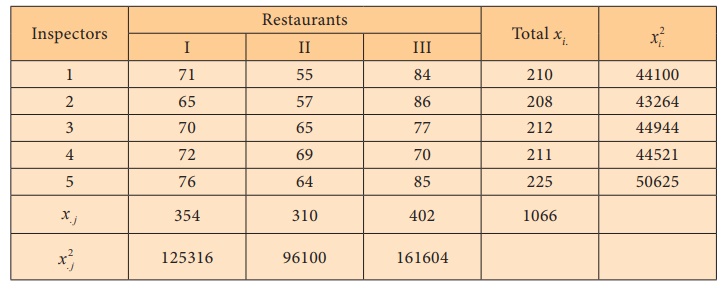
Squares
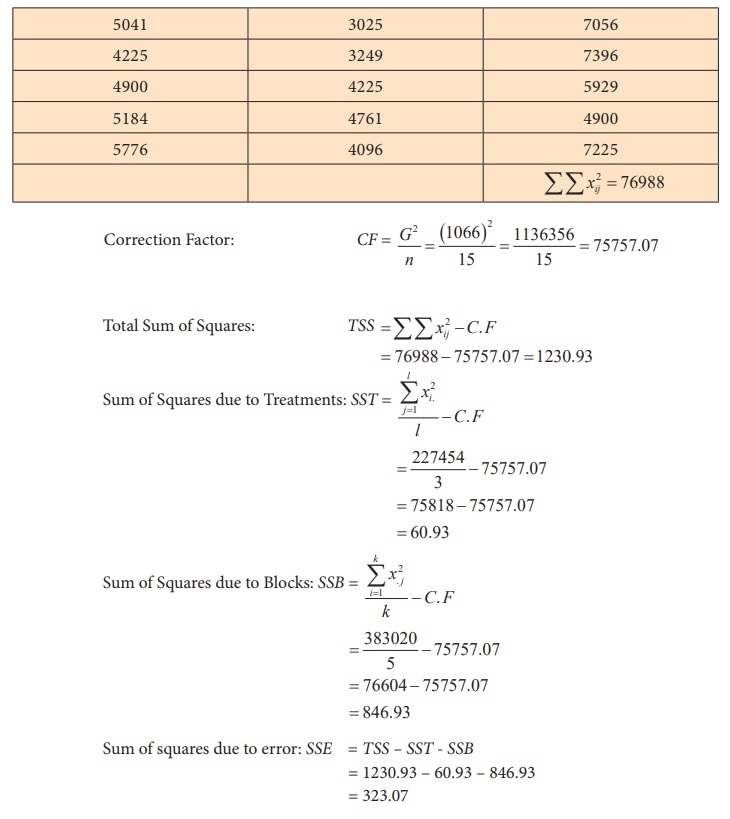
ANOVA Table (two-way)
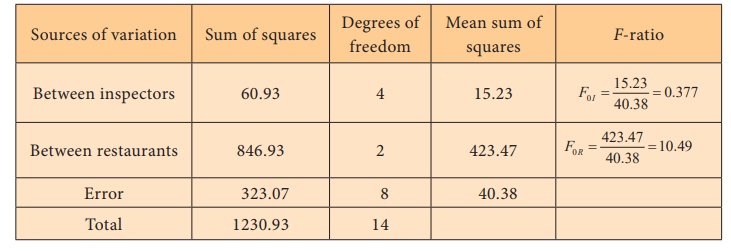
Step 6 : Critical values
f(4, 8),0.05 = 3.838 (for inspectors)
f(2, 8),0.05 = 4.459 (for
restaurants)
Step 7 : Decision
(i) As F0I = 0.377 <
f(4, 8),0.05 = 3.838, the null hypothesis is not rejected and
we conclude that there is no significant difference among the mean cleanliness
scores of inspectors.
(ii) As F0R = 10.49 > f(2,
8),0.05 = 4.459, the null hypothesis is rejected and we conclude that
there exists significant difference in atleast one pair of restaurants over
their mean cleanliness scores.
Related Topics